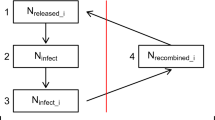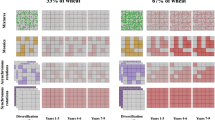Abstract
A seasonal model, where a growing season is defined as the time between sowing and harvest and alternates with an inter-crop period, was derived to study the effects of the ‘cost of virulence’ and cropping ratio on durability of resistance. We assumed a single strain of virulent pathogen, a single strain of avirulent pathogen and two cultivars (one resistant and one susceptible) and studied two measures of durability of resistance (‘take-over time’ and ‘usefulness time’). Take-over time is defined as the time needed for the virulent strain of the pathogen to reach a preset threshold and predominate over the previous pathogen population. Usefulness time is the time needed before the estimated gain in green canopy area duration per plant through the use of the resistant cultivar becomes negligible. The model suggested that, although it could take several seasons before the virulent strain of the pathogen predominated over the previous pathogen population, the usefulness time of the resistant cultivar was always much shorter. Furthermore, increasing selection for the virulent strain of the pathogen (through increasing the cropping ratio of the resistant cultivar) caused the virulent strain of the pathogen to invade the system more rapidly. Cost of virulence, reflecting differences in pathogen infection rates between the four possible combinations of cultivar/pathogen strain, significantly affected durability of resistance, with the dynamics of the virulent and avirulent strains ranging from a case where the virulent strain of the pathogen died out to a case where the virulent strain of the pathogen invaded the resident pathogen population. An intermediate state, where the system reached equilibrium and the virulent strain of the pathogen neither became predominant nor died out, was defined as ‘coexistence’ of both strains of the pathogen. Occurrence of coexistence was directly related to the cost of virulence since it did not occur when virulence of the pathogen did not have a fitness cost. Two methods to include cost of virulence in the model gave similar results in relation to the two measures of durability of resistance studied.
Similar content being viewed by others
References
JN Aubertot JS West L Bousset-Vaslin MU Salam MJ Barbetti AJ Diggle (2005) ArticleTitleModelling for integrated avirulence management: Case study of phoma stem canker of oilseed rape (Brassica napus) European Journal of Plant Pathology 114 91–106 Occurrence Handle10.1007/s10658-005-3628-z
H Brun S Levivier I Somda D Ruer M Renard AM Chèvre (2000) ArticleTitleA field method for evaluating the potential durability of new resistance sources: Application to the Leptosphaeria maculans–Brassica napus pathosystem Phytopathology 90 961–966 Occurrence Handle1:STN:280:DC%2BD1cjjslyitA%3D%3D Occurrence Handle18944519
H Brun V Huteau M Ermel F Eber AM Chèvre M Renard (2004) ArticleTitleField behaviour of oilseed rape genotypes carrying major resistance genes exposed to different Leptosphaeria maculans populations International Organisation for Biological Control Bulletin 27 95–100
R Delourme AM Chèvre H Brun T Rouxel MH Balesdent JS Dias P Salisbury M Renard SR Rimmer (2005) ArticleTitleMajor gene and polygenic resistance to Leptosphaeria maculans in oilseed rape (Brassica napus) European Journal of Plant Pathology 114 41–52 Occurrence Handle10.1007/s10658-005-2108-9
RE Gaunt (1995) ArticleTitleThe relationship between plant-disease severity and yield Annual Review of Phytopathology 33 119–144 Occurrence Handle10.1146/annurev.py.33.090195.001003 Occurrence Handle1:CAS:528:DyaK2MXosFWis7c%3D Occurrence Handle18288901
BJ Howlett (2004) ArticleTitleCurrent knowledge of the interaction between Brassica napus and Leptosphaeria maculans Canadian Journal of Plant Pathology 26 245–252 Occurrence Handle10.1080/07060660409507141
YJ Huang ZQ Li N Evans T Rouxel BDL Fitt MH Balesdent (2005) ArticleTitleFitness cost associated with loss of the AvrLm4 avirulence function in Leptosphaeria maculans (phoma stem canker of oilseed rape) European Journal of Plant Pathology 114 77–89 Occurrence Handle10.1007/s10658-005-2643-4
TM Hurley BA Babcock RL Hellmich (2001) ArticleTitleBt corn and insect resistance: An economic assessment of refuges Journal of Agricultural and Resource Economics 26 176–194
ML Kuhn L Gout BJ Howlett D Melayah M Meyer MH Balesdent T Rouxel (2005) ArticleTitleThe genome of Leptosphaeria maculans European Journal of Plant Pathology 114 17–31 Occurrence Handle10.1007/s10658-005-3168-6 Occurrence Handle1:CAS:528:DC%2BD2MXhtlSjtLbM
H Li K Sivasithamparam MJ Barbetti (2003) ArticleTitleBreakdown of a Brassica rapa subsp. sylvestris single dominant blackleg resistance gene in B. napus rapeseed by Leptosphaeria maculans field isolates in Australia Plant Disease 87 752
H Li L Damour K Sivasithamparam MJ Barbetti (2004a) ArticleTitleIncreased virulence and physiological specialization among western Australian isolates of Leptosphaeria maculans breaking down existing single dominant gene-based resistance in six cultivars of Brassica napus Brassica 6 9–16
H Li K Sivasithamparam MJ Barbetti J Kuo (2004b) ArticleTitleGermination and invasion by ascospores and pycnidiospores of Leptosphaeria maculans on spring-type Brassica napus canola varieties with varying susceptibility to blackleg Journal of General Plant Pathology 70 261–269 Occurrence Handle10.1007/s10327-004-0125-8
SJ Marcroft A Purwantara PA Salisbury TD Potter N Wratten R Khangura MJ Barbetti BJ Howlett (2002) ArticleTitleReaction of a range of Brassica species under Australian conditions to the fungus, Leptosphaeria maculans, the causal agent of blackleg Australian Journal of Experimental Agriculture 42 587–594 Occurrence Handle10.1071/EA01112
SJ Marcroft SJ Sprague SJ Pymer PA Salisbury BJ Howlett (2003) ArticleTitleFactors affecting production of inoculum of the blackleg fungus (Leptosphaeria maculans) in south-eastern Australia Australian Journal of Experimental Agriculture 43 1231–1236 Occurrence Handle10.1071/EA02117
BA McDonald C Linde (2002) ArticleTitlePathogen population genetics, evolutionary potential, and durable resistance Annual Review of Phytopathology 40 349–379 Occurrence Handle10.1146/annurev.phyto.40.120501.101443 Occurrence Handle12147764 Occurrence Handle1:CAS:528:DC%2BD38Xos1Cltbg%3D
S Pietravalle F Bosch Particlevan den N Evans (2004) ArticleTitleDurability of resistance, a modelling approach International Organisation for Biological Control Bulletin 27 119–123
Regev U (2002). Pest resistance in agriculture: An economic perspective. The Economics of Managing Biotechnologies (pp. 51–69). Kluwer Academic Publishers
U Regev H Shalit AP Gutierrez (1983) ArticleTitleOn the optimal allocation of pesticides with increasing resistance - the case of Alfalfa Weevil Journal of Environmental Economics and Management 10 86–100 Occurrence Handle10.1016/0095-0696(83)90017-7
T Rouxel A Penaud X Pinochet H Brun L Gout R Delourme J Schmit MH Balesdent (2003) ArticleTitleA 10-year survey of populations of Leptosphaeria maculans in France indicates a rapid adaptation towards the Rlm1 resistance gene of oilseed rape European Journal of Plant Pathology 109 871–881 Occurrence Handle10.1023/A:1026189225466 Occurrence Handle1:CAS:528:DC%2BD3sXotV2jsbg%3D
TK Turkington GW Clayton H Klein-Gebbinck DL Woods (2000) ArticleTitleResidue decomposition and blackleg of canola: influence of tillage practices Canadian Journal of Plant Pathology 22 150–154
F Bosch Particlevan den CA Gilligan (2003) ArticleTitleMeasures of durability of resistance Phytopathology 93 616–625 Occurrence Handle18942985
AD Wherrett K Sivasithamparam MJ Barbetti (2004) ArticleTitleEstablishing the relationship of ascospore loads with blackleg (Leptosphaeria maculans) severity on canola (Brassica napus) Australian Journal of Agricultural Research 55 849–854 Occurrence Handle10.1071/AR04026
Author information
Authors and Affiliations
Corresponding author
Rights and permissions
About this article
Cite this article
Pietravalle, S., Lemarié, S. & van den Bosch, F. Durability of Resistance and Cost of Virulence. Eur J Plant Pathol 114, 107–116 (2006). https://doi.org/10.1007/s10658-005-3479-7
Accepted:
Issue Date:
DOI: https://doi.org/10.1007/s10658-005-3479-7




